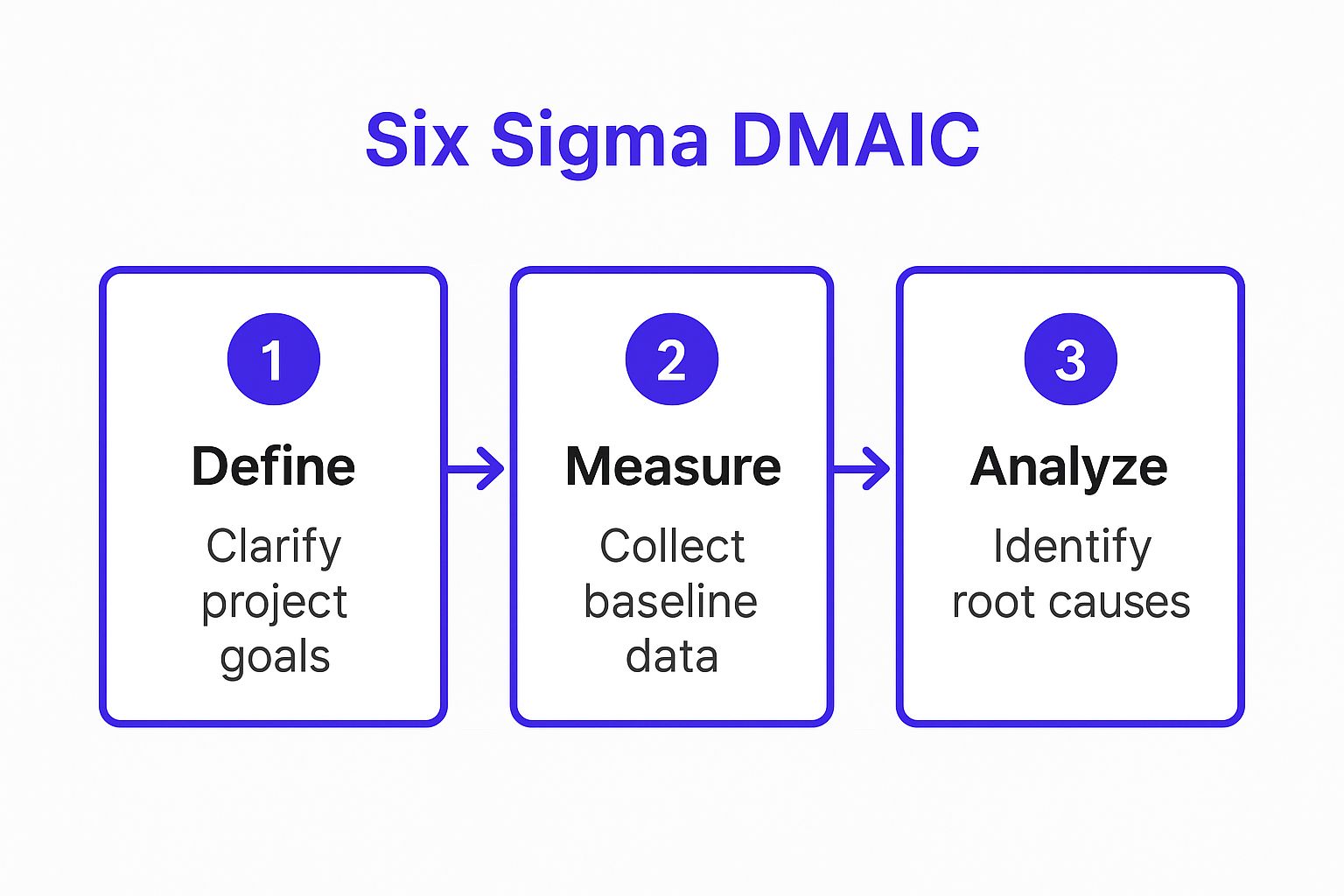In today's fast-paced, remote-first work environment, the ability to effectively tackle complex challenges is more critical than ever. Generic brainstorming sessions often fall flat, hindered by cognitive biases and the logistical hurdles of virtual collaboration. This article cuts through the noise, offering a curated list of nine powerful problem solving techniques designed to drive clarity and innovation for your team.
We'll explore proven methodologies, from the data-driven rigor of Root Cause Analysis to the creative exploration of Design Thinking. Each section provides a clear, step-by-step framework you can immediately apply to your projects. You will learn not just what these techniques are, but how to implement them effectively within a remote or hybrid team structure. For teams looking to master these skills, applying them through hands-on practice is key; exploring effective scenario-based training can significantly transform learning results and practical application.
This guide moves beyond theory. We provide actionable guidance on implementing these strategies, highlighting how specialized platforms like Bulby can transform these frameworks into practical, repeatable successes. By mastering these approaches, your team can move beyond symptom-fixing to address root causes, fostering a culture of continuous improvement and unlocking truly groundbreaking solutions.
1. Root Cause Analysis (RCA)
Root Cause Analysis is a powerful problem solving technique that moves beyond treating symptoms to uncover the fundamental origin of an issue. Instead of just patching a leak, RCA helps you find and fix the faulty pipe causing it. This approach ensures that you don't just solve a problem for now; you prevent it from ever happening again.
This method is crucial for tackling complex, recurring issues where surface-level fixes have failed. For instance, an effective approach to understanding customer attrition involves methodologies like learning from churn, which helps uncover underlying issues that lead customers to leave.

How to Apply RCA with Your Team
Successfully implementing RCA involves a structured, collaborative effort. It’s not about pointing fingers but about improving systems.
- Assemble a Diverse Team: Gather individuals from different departments with varied expertise. A developer, a customer support agent, and a product manager will see the same problem from unique, valuable angles.
- Use the "5 Whys" Technique: A core component of RCA, this simple yet effective method involves asking "Why?" repeatedly until you reach the root cause. Each answer forms the basis of the next question.
- Focus on Processes, Not People: The goal is to identify systemic flaws. Frame the investigation around "what went wrong with the process" rather than "who made a mistake."
Implementing with Bulby
For remote teams, Bulby’s platform streamlines the RCA process. You can create a dedicated RCA project board, invite cross-functional team members, and use shared whiteboards to visually map out the "5 Whys" or create a Fishbone Diagram. Assign action items directly from the analysis to ensure corrective measures are implemented and tracked effectively.
2. Design Thinking
Design Thinking is a human-centered problem solving technique that puts user needs at the heart of innovation. Rather than jumping to a solution, it focuses on deeply understanding the people you're designing for. This iterative process integrates user empathy, technological possibilities, and business viability to create solutions that are not just functional but truly desirable.
This approach is invaluable for tackling ambiguous or ill-defined problems where the exact issue isn't clear. The initial 'Empathize' phase, for instance, relies heavily on understanding user perspectives, and effective strategies for analyzing customer feedback are crucial for gathering the deep insights needed to drive innovation.

How to Apply Design Thinking with Your Team
Implementing Design Thinking requires a shift in mindset towards curiosity, collaboration, and experimentation. It encourages teams to explore and learn together.
- Start with Empathy: Go beyond surveys. Conduct user interviews, observe them in their environment, and create empathy maps to genuinely understand their pains and motivations.
- Embrace Ambiguity and Ideate: Encourage wild ideas without judgment in the ideation phase. The goal is quantity over quality at this stage to explore every possible angle.
- Prototype and Test Rapidly: Build low-fidelity, inexpensive prototypes (like sketches or wireframes) to make your ideas tangible. Get them in front of users early and often to gather feedback and iterate.
Implementing with Bulby
Bulby provides the perfect virtual environment for a remote Design Thinking process. Your team can use a dedicated board to manage the entire five-stage workflow: Empathize, Define, Ideate, Prototype, and Test. Use Bulby's collaborative whiteboards to build user journey maps and affinity diagrams. For ideation, team members can add ideas to a shared space, and you can facilitate a virtual Design Thinking workshop using a structured template. Tasks can be created directly from winning ideas to move seamlessly from prototype feedback to development.
3. Six Sigma DMAIC
Six Sigma DMAIC is a highly structured, data-driven problem solving technique designed to optimize and improve business processes. Standing for Define, Measure, Analyze, Improve, and Control, this five-phase methodology provides a rigorous framework for eliminating defects and reducing variability. By using statistical analysis, DMAIC moves beyond guesswork to make informed decisions, ensuring solutions are both effective and sustainable.
This method is ideal for tackling complex operational inefficiencies where the root causes are not immediately obvious. For example, a bank could use DMAIC to significantly reduce loan processing times, or a manufacturing plant might implement it to minimize product defects and waste. The core strength of this approach lies in its focus on quantifiable results and process control.
This infographic outlines the foundational phases of the DMAIC process, showing how teams move from clarifying goals to identifying root causes.

This structured flow ensures that solutions are based on solid evidence rather than assumptions.
How to Apply DMAIC with Your Team
Implementing DMAIC requires discipline, collaboration, and a commitment to data-driven decision-making. It's a team sport focused on measurable improvement.
- Define the Problem Clearly: Start by creating a detailed project charter. This document should outline the problem, project goals, scope, and key stakeholders. Ensure everyone on the team has a shared understanding of what success looks like.
- Focus on Data Accuracy: In the Measure phase, collecting accurate baseline data is critical. Use consistent methods and tools to measure the current process performance. This data will be the foundation for your analysis.
- Leverage Statistical Tools: During the Analyze phase, use statistical tools like Pareto charts, scatter plots, or regression analysis to identify the verified root causes of the problem. This prevents the team from jumping to conclusions.
Implementing with Bulby
For remote teams, Bulby provides the perfect environment for a DMAIC project. You can create a dedicated project space and use its task management features to assign and track activities for each of the five phases. Utilize Bulby’s integrations to pull in performance data from other tools, and use shared documents to collaborate on the project charter and analysis reports. This keeps your entire data-driven problem solving process organized and accessible to all team members, no matter where they are.
4. Brainstorming
Brainstorming is a classic yet powerful creative problem solving technique designed to generate a large volume of ideas in a free-flowing, non-judgmental environment. Popularized by advertising executive Alex Osborn, its core principle is to prioritize quantity over quality in the initial phase, deferring criticism to allow for maximum creative exploration. This approach helps teams break free from conventional thinking and uncover innovative solutions.
This method is ideal for the early stages of problem-solving when you need to explore a wide range of possibilities. It’s used everywhere from 3M's legendary innovation sessions to advertising agencies developing new campaign concepts. The goal is to create a rich pool of ideas that can be filtered and refined later.

How to Apply Brainstorming with Your Team
A successful brainstorming session is more than just an unstructured conversation; it requires a clear framework to foster creativity and collaboration.
- Define the Problem Clearly: Start with a specific, well-defined problem statement or question. A vague prompt leads to unfocused ideas, while a clear one like "How can we reduce our app's onboarding time by 20%?" provides a solid target.
- Encourage Wild Ideas: The facilitator should create a safe space where no idea is considered "stupid." Often, the most outlandish suggestions can spark more practical, innovative solutions. Emphasize that evaluation comes later.
- Build on Others' Ideas: Foster a "yes, and…" mindset. Encourage participants to listen actively and build upon the concepts shared by others, combining or modifying them to create even better ones.
Implementing with Bulby
For distributed teams, Bulby’s platform transforms brainstorming from a chaotic video call into a structured, engaging activity. You can create a dedicated "Ideas Board" where team members can post virtual sticky notes in real-time. Use the timer feature to run short, focused ideation sprints (e.g., Round Robin Brainstorming) and utilize anonymous submission options to encourage participation from quieter team members. After the session, easily group related ideas and use built-in polling tools to vote on the most promising concepts, ensuring a clear path from ideation to action.
5. Lean Problem Solving (A3 Thinking)
A3 Thinking is a structured problem solving technique that originated from Toyota's renowned lean manufacturing system. It gets its name from the A3-sized paper used to document the entire problem-solving process on a single sheet, forcing teams to be concise, visual, and systematic in their approach to identifying, analyzing, and solving complex issues.
This method is ideal for tackling operational inefficiencies where a clear, documented path from problem to solution is needed. For example, healthcare organizations use it to improve patient flow, and software companies apply it to resolve development bottlenecks. This focus on a shared understanding makes it a cornerstone of effective collaborative problem-solving.
How to Apply A3 Thinking with Your Team
Implementing A3 Thinking encourages deep, data-driven analysis and shared ownership of the solution. It’s a powerful way to align everyone on a single, clear plan.
- Define the Problem Clearly: Start by creating a concise and agreed-upon problem statement. What is happening, where is it happening, and what is its impact? This sets a solid foundation for the entire process.
- Visualize the Current State: Use data, flowcharts, and diagrams to map out the existing process. This factual, visual approach helps the team understand the reality of the situation without relying on opinions or assumptions.
- Develop and Test Countermeasures: Instead of jumping to one big solution, brainstorm several small, testable countermeasures. The goal is to experiment and learn what truly works to address the root cause you've identified.
Implementing with Bulby
For remote teams, Bulby’s platform acts as a digital A3 canvas. You can create a dedicated board for your A3 project, using different columns to represent each step of the process from "Problem Background" to "Follow-Up Plan." Attach charts, data files, and interview notes directly to cards. Use Bulby's collaborative document editor to draft the A3 report together in real-time, ensuring every stakeholder contributes and stays aligned from start to finish.
6. SCAMPER Technique
The SCAMPER technique is a creative problem solving technique that uses a checklist of action verbs to spark new ideas. Instead of waiting for a random flash of inspiration, SCAMPER provides a structured framework to examine a problem or existing product from seven different angles. It acts as a prompt, pushing you to innovate by systematically questioning the status quo.
This method, popularized by Bob Eberle, is exceptionally useful for product development, feature ideation, and marketing campaigns. For instance, a product team could use SCAMPER to brainstorm new features for a mobile app by asking questions like, "What can we substitute to make it simpler?" or "How can we combine it with another service?"
How to Apply SCAMPER with Your Team
Applying SCAMPER effectively transforms a standard brainstorming session into a more focused and productive ideation workshop. It encourages lateral thinking by forcing the team to consider possibilities they might otherwise overlook.
- Define the Focus: Clearly state the problem or product you want to improve. Everyone on the team needs to have the same starting point.
- Go Through Each Letter Systematically: Work through each of the seven prompts: Substitute, Combine, Adapt, Modify, Put to another use, Eliminate, and Reverse. Use a dedicated time slot for each letter.
- Encourage Wild Ideas: The goal is quantity over quality in the initial phase. Defer judgment and capture every idea, no matter how impractical it seems at first. The most innovative solutions often come from unexpected places.
Implementing with Bulby
Bulby is ideal for facilitating a remote SCAMPER session. You can set up a project board with seven distinct columns, one for each letter of the acronym. Team members can add their ideas as cards to the appropriate column in real-time, creating a visual and organized collection of concepts. Use Bulby’s built-in timer to keep the session paced and focused as you move from one letter to the next. After the session, you can easily drag and drop ideas to a "To Discuss" column for further evaluation and prioritization.
7. Fishbone Diagram (Ishikawa Diagram)
The Fishbone Diagram, also known as an Ishikawa Diagram, is a visual problem solving technique used to identify, explore, and display all potential causes of a specific problem. Its structure resembles a fish skeleton, with the "head" representing the problem statement and the "bones" branching off to represent major categories of potential causes. This method provides a structured way to brainstorm and ensures a comprehensive analysis.
This technique is exceptionally useful for untangling complex issues where multiple factors could be at play. For instance, a software team can use a Fishbone Diagram to systematically investigate the reasons behind slow application performance, grouping potential causes into categories like Code, Infrastructure, Database, and User Load. It organizes thinking and prevents teams from overlooking crucial contributing factors.
How to Apply the Fishbone Diagram with Your Team
Creating a Fishbone Diagram is a collaborative exercise that visually maps out the relationship between a problem and its potential sources, promoting a shared understanding.
- Define the Problem Clearly: Start with a precise, agreed-upon problem statement. Write this at the "head" of the fish. An ambiguous problem will lead to a confusing and ineffective diagram.
- Establish Major Cause Categories: Use standard categories like the 6 Ms (Manpower, Method, Machine, Material, Measurement, Milieu/Mother Nature) or create custom ones relevant to your context, such as People, Process, and Technology. These will form the main "bones" of your diagram.
- Brainstorm Potential Causes: For each major category, ask the team "Why might this be happening?" List all potential causes as smaller "bones" branching off the main ones. Encourage a free flow of ideas without judgment.
Implementing with Bulby
For remote teams, Bulby’s collaborative whiteboard is the perfect canvas for building a digital Fishbone Diagram. You can start with a central problem statement and invite team members to add branches and causes in real-time. Use different colored sticky notes to represent categories and potential causes. This visual collaboration helps keep everyone engaged and ensures all perspectives are captured, turning a complex analysis into a dynamic and interactive session. You can then link identified causes directly to new tasks in your project board to ensure follow-through.
8. Mind Mapping
Mind Mapping is a dynamic, visual problem solving technique that helps organize thoughts and explore complex ideas. It starts with a central problem or concept, from which related ideas, tasks, and questions branch out like a tree. This method encourages free-flowing, non-linear thinking, making it easier to see connections and generate creative solutions that a linear list might miss.
This technique is exceptionally useful when you need to break down a large, intimidating problem into manageable parts or brainstorm a wide array of potential solutions. For instance, when planning a new product launch, a mind map can capture everything from marketing strategies to technical requirements in a single, interconnected view. To explore this and other brainstorming methods in more depth, learn how mind mapping fuels creative problem solving.
How to Apply Mind Mapping with Your Team
Effective mind mapping is a collaborative exercise that turns abstract ideas into a shared visual reality. The focus is on exploration, not immediate perfection.
- Establish a Central Theme: Start with a clear, concise statement of the problem or topic at the center of your map. This ensures everyone is focused on the same goal.
- Encourage Free Association: Let ideas flow without judgment. Use single keywords or short phrases for branches, and encourage the use of colors and simple images to stimulate memory and creativity.
- Build Out Branches: From your main ideas, create smaller sub-branches to add details, questions, or next steps. This hierarchical structure helps organize information and reveal deeper relationships between different parts of the problem.
Implementing with Bulby
Bulby’s digital whiteboard is the perfect canvas for remote team mind mapping. You can start with a central node and invite team members to add branches in real-time. Use color-coded sticky notes for different themes and connect ideas with lines and arrows to show relationships. The infinite canvas means your map can grow as large as your ideas, and afterward, you can convert key nodes directly into trackable tasks within your project board.
9. The 5 Whys
The 5 Whys technique is an elegantly simple yet profoundly effective method for drilling down past surface-level symptoms to find the true origin of a problem. Popularized by the Toyota Production System, this approach involves repeatedly asking "Why?" to trace a chain of cause-and-effect relationships back to a fundamental, fixable source. The goal is to move beyond quick fixes and implement lasting solutions.
This problem solving technique is invaluable for its simplicity and can be applied to almost any issue, from IT system failures to customer service complaints. By forcing a deeper investigation, it helps teams avoid the trap of addressing symptoms, ensuring that the same problem doesn't resurface. For example, a customer complaint about a late delivery might uncover a systemic bottleneck in the logistics process.
How to Apply The 5 Whys with Your Team
Conducting a 5 Whys session is a collaborative exercise focused on discovery, not blame. It fosters a culture of continuous improvement and shared ownership.
- Gather a Knowledgeable Team: Bring together individuals who are directly familiar with the problem. Their firsthand experience is crucial for providing accurate answers to each "Why?".
- Focus on Processes, Not People: The investigation should always center on systemic failures. Frame questions around "Why did the process fail?" instead of "Who made a mistake?" to maintain a constructive and safe environment.
- Use Facts and Data: Base each answer on evidence and data, not on assumptions or speculation. This ensures the causal chain is accurate and leads to the true root cause. Remember, you might need more or fewer than five "whys" to get there.
Implementing with Bulby
For distributed teams, Bulby makes conducting a 5 Whys session seamless. You can start a dedicated project channel and use a shared digital whiteboard to visually map out the question-and-answer flow. Document each "Why" and its corresponding answer in a shared document, then use Bulby’s task management features to assign action items to address the identified root cause. This creates a clear, trackable record from problem identification to resolution.
9 Problem Solving Techniques Comparison
| Technique | Implementation Complexity 🔄 | Resource Requirements ⚡ | Expected Outcomes 📊 | Ideal Use Cases 💡 | Key Advantages ⭐ |
|---|---|---|---|---|---|
| Root Cause Analysis (RCA) | High – requires skilled facilitators and multiple tools | High – time-intensive and resource-heavy | Effective prevention of problem recurrence and system reliability improvement | Complex, recurring problems with significant impact | Addresses core issues, reduces long-term costs, data-driven |
| Design Thinking | Moderate – iterative, requires cultural shift | Moderate – collaborative team efforts | Innovative user-centered solutions with rapid prototyping | Innovation challenges, user experience, complex social issues | Encourages creativity, builds collaboration, focuses on user needs |
| Six Sigma DMAIC | High – structured statistical methodology | High – training and data-intensive | Measurable process improvements and defect reduction | Process improvement, quality issues, operational efficiency | Produces measurable results, sustainable improvements, analytical |
| Brainstorming | Low – open, easy to implement group sessions | Low – minimal resources needed | Numerous creative ideas and team engagement | Creative challenges, early problem exploration | Generates many ideas quickly, promotes collaboration |
| Lean Problem Solving (A3 Thinking) | Moderate – structured, requires training | Moderate – focused team involvement | Clear, concise problem documentation and systematic solutions | Operational problems, process improvements, organizational learning | Visual management, encourages systematic thinking |
| SCAMPER Technique | Low to moderate – simple checklist-based | Low – easy to learn and apply | Diverse innovative solutions through guided creativity | Product innovation, creative challenges, improving solutions | Easy to use, stimulates lateral thinking, adaptable |
| Fishbone Diagram (Ishikawa) | Moderate – requires facilitation | Moderate – team-based analysis | Comprehensive cause identification and problem clarity | Complex problems with multiple causes, quality issues | Visual, comprehensive cause analysis, encourages participation |
| Mind Mapping | Low to moderate – flexible, visual tool | Low – minimal tools required | Enhanced creative thinking and information organization | Complex problem analysis, creative thinking, planning | Shows relationships visually, flexible and engaging |
| The 5 Whys | Very low – simple questioning technique | Very low – no special tools or training | Quick identification of root causes for simple problems | Simple to moderate problems, initial investigations | Easy to use, fast, promotes deep thinking |
From Technique to Transformation: Putting Your Plan into Action
You now have a powerful arsenal of problem solving techniques at your disposal. We've journeyed through methods like Root Cause Analysis and the 5 Whys, which help you dig deep to find the source of an issue, and explored creative frameworks like Design Thinking and SCAMPER that expand your team's innovative potential. Each technique, from the structured Six Sigma DMAIC process to the visual clarity of a Fishbone Diagram, offers a unique path to a solution.
But knowing these techniques is only half the battle. The true differentiator between a team that struggles and a team that thrives is the ability to move from theory to consistent, collaborative action. The real value emerges when these methods become ingrained in your team’s culture, turning complex challenges into opportunities for growth and innovation.
The Bridge Between Knowing and Doing
For remote and hybrid teams, this transition can be especially challenging. How do you facilitate a dynamic brainstorming session or a detailed A3 problem-solving exercise when your team is spread across different locations and time zones? This is where structure and the right digital environment become critical. Simply hopping on a video call isn't enough to capture the disciplined, focused thinking required by these powerful frameworks.
The goal is to create a process, not just have a meeting. A successful problem-solving culture relies on three core pillars:
- Structure: Applying a consistent framework that guides the team from problem definition to solution implementation.
- Collaboration: Ensuring every team member has an equal opportunity to contribute their insights, free from bias or groupthink.
- Action: Translating ideas and analysis into concrete, measurable steps that lead to real-world results.
Building a Resilient Problem-Solving Engine
Mastering these problem solving techniques transforms your team from being reactive to proactive. Instead of putting out fires, you begin to build fireproof systems. By systematically identifying root causes, exploring a wide range of creative solutions, and making data-informed decisions, you build resilience. Your team learns to anticipate challenges, adapt to change, and consistently deliver superior outcomes.
This proactive stance is what separates industry leaders from the rest. It fosters a culture of continuous improvement and psychological safety, where every team member feels empowered to identify issues and contribute to solutions. Whether you're a startup navigating market uncertainties or an established company looking to innovate, embedding these structured problem-solving habits is your key to sustained success. The ultimate goal isn't just to solve the problem in front of you; it's to build a team that can solve any problem that comes next.
Ready to turn these techniques into your team’s superpower? Bulby provides the structured, AI-powered environment you need to implement methods like Design Thinking and Root Cause Analysis effectively in a remote setting. Start your journey toward more innovative, efficient problem-solving today by exploring the platform at Bulby.

